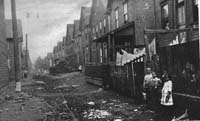Company Towns, Chicago (1893)

Pullman Palace Car Company was famous for the rail cars they manufactured in the late 1880s to the early 1890s. In Chicago, George M. Pullman founded the town of Pullman, Chicago which was a company town that he had his employees live. This town included everything from a library to parks. In light of giving his employees a place to live, Pullman then implemented a wage cut which accumulated increasingly to twenty-five percent. On top of this, the rent to live in Pullman, Chicago was over twenty-five percent more expensive then to live in the outskirts; and you could only work for Pullman Palace if you lived in Pullman. As a result workers formed a committee to ask for a raise, to which they were denied. On May 10 1894, all the employees went on strike and on May 11, 1894, Pullman Palace Car Company in Pullman, Chicago closed down. This local company town strike went viral domestically, and Pullman employees across 27 different states also went on strike, causing the Pullman Strike of 1894. This included over 150,000 Pullman employees and became a milestone in American labor history. President Cleveland at the time ordered federal troops to stop the strikes, and dozens were killed by violence. As a result, big companies like the Pullman Palace Car Company took advantage of their employees by decreasing their wages-meanwhile they masqueraded a company town that was supposed to benefit their workers-only making them increasingly in debt.
Company Town, West Virginia (1902)
This source is a picture of a long row of homes built in a company town in Beckley, West Virginia, in 1902. Published in 2015 on the library of Virginia Commonwealth University (VCU), the picture shows closely built houses that are identical, with a narrow street in between another row of homes which are identical. The audience of this source is the wealthy company owners, and other Americans who live in urban areas to shine light on rural areas with no resources have turned into company towns-which are not ideal living areas. The heading underneath the photo states: “Houses were built as closely together as possible”. This alludes to the point that companies crammed these living spaces to hold as many working employees as possible. This connects to my project theme because it shows the economic gap and difference in standards of living from the people that own the company, to people that work for the company. This company town in Beckley is housing for N&W Virginia Railroads, a monopoly that accumulated most wealth in their industry, forcing low skilled workers to comply and settle as a low income employee in a company they will never compete with, or positionaly move up in. As a result, these company towns contribute to the economic inequality.
Ford Motor Company, Highland Park Michigan 1914
This source is a picture of an assembly line around 1914 in Highland Park, Michigan at the Ford Motor Company factory; and the photographer is unknown. The key points in the source show the few men (6 pictured) working on a long assembly, to create the Model T sample car. It shows the efficiency that the assembly line allows, as few workers are depicted amongst a long assembly line, as they manufacture multiple cars at once. This source connects to my projects theme to show that this new innovation had minimize the employment needed to create multiple cars at once. The warehouse and assembly line in the photo show the boom of innovation in the new age of technology, which reduced low skill workers and increased efficiency; adding up to a capitalistic market.
